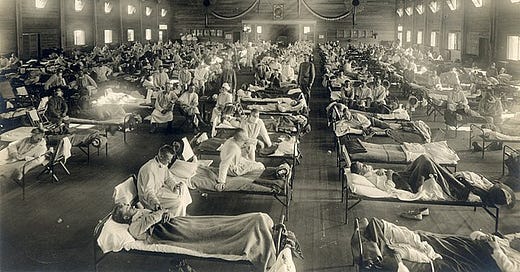When Contagion Failed the Test
In 1918, scientists tried to infect healthy volunteers with the Spanish flu. It didn’t work. The study disappeared.
In the golden age of “Trust the Science,” one of the most rigorous scientific experiments ever conducted on infectious disease is nowhere to be found in modern textbooks, university syllabi, or even Wikipedia. It’s been quietly scrubbed from the historical record, erased from public memory like a scene cut from a film that didn’t test well with audiences.
The experiment took place in 1918. The disease? The so-called Spanish Flu—supposedly one of the deadliest pandemics in modern history. The U.S. Public Health Service, under the direction of Dr. Milton Rosenau, launched an extraordinary series of human trials to determine how influenza was transmitted.
And here’s what they found: they couldn’t get anyone sick.
In a study conducted at Gallops Island, healthy Navy volunteers were exposed to bodily fluids from Spanish flu victims. Mucus was transferred from sick to well. Subjects were coughed on, sneezed at, injected, swabbed, and prodded. Nothing. Not a single healthy person developed symptoms of influenza.
Rosenau’s baffled conclusion? “We came out of it with the sense that we knew very little about it.”
You’d think such a dramatic failure to prove transmission would spark decades of re-evaluation. But instead of forcing a hard look at the assumptions underlying germ theory, the experiment was memory-holed.
It’s not in Wikipedia’s article on the Spanish Flu.
It’s absent from most virology textbooks.
It’s not mentioned in Rosenau’s own obituaries.
Why? Because Rosenau’s study undermines the sacred cow of the modern public health narrative: that viruses spread easily from person to person and that contagion is self-evident.
If that assumption collapses, so does the rationale for lockdowns, masks, social distancing, and mass vaccination programs.
Instead of grappling with that scientific bombshell, the public health establishment did what bureaucracies do best: they pretended it never happened.
We live in a time when ‘disinformation’ is policed with a religious fervor, yet the most inconvenient facts—historically documented, peer-reviewed, government-funded studies—are buried deeper than nuclear waste. Meanwhile, the media obediently repeats: “The science is settled.”
But science is never settled. Especially not when it’s been so carefully curated to exclude anything that contradicts the prevailing dogma.
It’s time to ask hard questions:
Why was the Rosenau study buried?
Why are experiments that contradict germ theory ignored rather than refuted?
How many of our assumptions about viral transmission are based not on evidence, but on fear, funding, and inertia?
This isn’t just about the past. It’s about the next pandemic, the next lockdown, the next mandate. Because if we’ve built our response protocols on a theory that couldn’t even survive its own field test, what else are we wrong about?
And who benefits from that ignorance?
Reintroducing Rosenau’s forgotten experiment isn’t revisionist history. It’s restoration.
And it’s long overdue.




I fully agree with your postulates,
Ceath to Big Pharma! Prepare the hanging ropes
Excellent expose of the deception regarding the inability to transfer the flu. Have you looked into how many patents have been issued to Rockefeller University in the last two decades? They are in excess of 6000. They are all medically related. Included are beauties such as how to give someone hepatitis and how to cure it. Let me know if you are as horrified as I am.